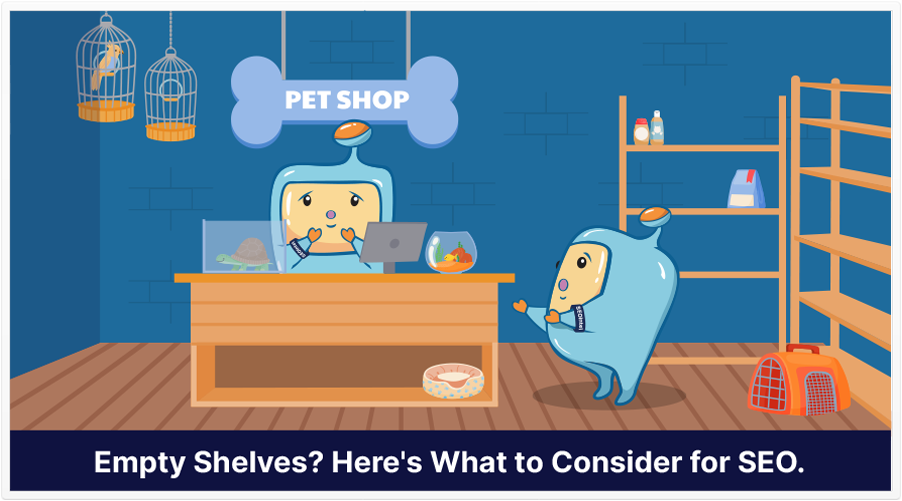
In short, you can either remove the pages/URLs that correspond to out-of-stock-items, or you can keep them live.
Now, there’s a legitimate concern that comes with keeping out-of-stock URLs live: a negative user experience, because users don’t find what they want (or…technically, they do, but it’s just that it’s unavailable, which is the point).
This is a tricky one, as you might hear if you listen to the video below (which is queued to the 33-minute, 39-second mark, which is where John Mueller encountered and addressed the question).
The question–or rather, situation–was:
“My client is having a rather unique issue that is relevant to the times.
“Ordinarily, I would recommend that if a product is out of season or out of stock that they keep the URL live and put a note to the user as to when the product will be available.
“With supply chain shortages, this company is experiencing an inordinate amount of temporarily out-of-stock products, and this creates a negative user experience. How do we balance the user experience with SEO?
“They want to take all the URLs offline so that the customers stop complaining about the number of out-of-stock items on the e-commerce site.”
(Below, I bolded the words ‘this means their URLs and SEO is impacted,’ because I want to call your attention to those words: their URLs and SEO may not be as negatively impacted as one may think. John confirms this.)
The situation continues:
“However, this means their URLs and SEO is impacted.”
John Mueller’s (Google’s) Response
“Yeah, I don’t know. I think this is always a bit challenging, specifically around out-of-stock and temporarily out-of stock-content.
“It is something where what works best for us is if we can keep the URL online for things that are really temporary, in the sense that if the URL remains indexable, and with structured data you tell us this product is currently not available, then we can at least kind of…keep this URL in our index and keep refreshing it regularly to pick up that change in availability as quickly as possible.
But, if You Decide to noindex Those URLs…
“However, if you decide to noindex these pages, or if you decide to just remove the internal linking to these pages, then when that state changes back, we should try to pick that up fairly quickly as well. And we try to understand these state changes through things like site maps and internal links.
“So especially if you add a product back, and then suddenly it has internal links again, that helps us to pick that up again. You can speed this up a little bit by being a bit deliberate with your internal linking.
When You Do Bring Those URLs Back, Link to Them From This Page…
“So in particular, like I think one of the questions earlier, when things are linked from the home page, we think that they’re a little bit more important.
“And we go off and try them out fairly quickly. If you add those products back, and if you add a link to your home page saying, ‘Oh, these things are now in stock again,’ then we can take that and say, ‘Oh, this seems to be an important thing.’
“We will double-check these pages a bit quicker. And we’ll see if they’re actually now in stock or not.
“So that’s kind of the direction I would go there.
Merchant Center Feed
“So that’s kind of the direction I would go there. I think also, with regards to in-stock and not in stock, especially when it comes to products, one thing you can also do is kind of hedge your SEO together with product search. So if you submit a Merchant Center feed, then we can also show those products within the…I don’t know what it’s called…the product search side bar thing, or product listing ads I think it used to be called. I don’t know what the current name is. We can also show those products there. And we can show them there based on the feed.
“So we don’t necessarily need to recrawl the individual pages to recognize, ‘Oh, the page says it’s in stock.’ We can just recognize in the feed that you submit to us, like suddenly the availability changed.
“We can put that back in. So those are kind of the aspects there. On the one hand, if you want to remove it with a noindex, or just remove internal links, that’s fine.
(I’d say, if you want to remove with a noindex, then go the full way and remove the internal links, too. That way, customers won’t accidentally navigate to those pages.)
John continued:
“That’s up to you. If you change it back, make sure to make it so that we recognize those changes as quickly as possible. And ideally, also use the Merchant Center feed to kind of hedge your bets with regards to SEO so that it doesn’t depend purely on recrawling all of these pages.”
Conclusion
So, I think that John has done a great job at giving you all–or, at least most–of your options.
While having a lot of noindex pages eventually means you may lose search traffic, it seems that when those products return, you can get those pages reindexed rather quickly, if you use the Merchant Center feed, internal linking, and of course, removing the noindex.